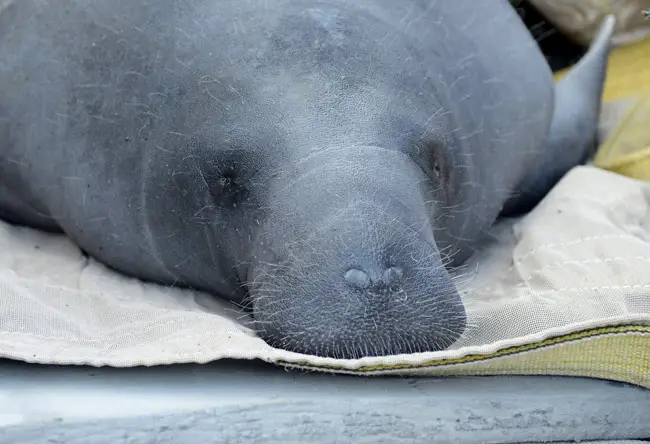
By Katie Tripp
In response to a lawsuit by the Pacific Legal Foundation, the U.S. Fish and Wildlife Service (FWS) has decided that downlisting manatees from endangered to threatened under the federal Endangered Species Act may be warranted. The agency is embarking on a 5-year status review as part of the process.

Let me be very clear about the seriousness of the situation: from 2010-2013, 2,441 manatees died in Florida waters, which is 48 percent of the highest minimum population ever recorded (5,077 in 2010), but we’d have to wait until after 2015 to be able to include these data. However, ignoring this information would also constitute a substantial and unacceptable bias. Reviews are important, but when they’re going to be tied to a decision that could alter the fate of a species, they need to contain the best and most updated data and information. Unfortunately for manatees, the data from the winters of 2010-2013 – including record mortality for the species, the worst ever recorded red tide that resulted in manatees being committed to mass graves in southwest Florida, and a new, mysterious cause of death that has not yet even been labeled in the Indian River Lagoon – won’t be in the mix because the most recent two years of data are left out of the models to avoid bias.
A tool used during the review process is the Core Biological Model (CBM). In May 2013, the Manatee Forum, a group of 22 stakeholder organizations, received an update on this model as it related to the then-anticipated FWS status review. An appropriate sentiment on models was best stated by George Box, a British mathematician who said, “all models are wrong, but some are useful.”
The devil is in the details with a model, and some of the details related to the CBM are not in the manatees’ favor. First, the group was told that the most current data only went through 2012 for the Atlantic and Upper St. Johns River, 2010-2011 for Northwest Florida, and only through 2009-2010 for Southwest Florida. Data for survival rates only represent the years 2006-2008. We were also told that previous predictions for red tide estimated severe events in 15 percent of years, but the new model would dial that up to 35 to 45 percent of years, based on expert opinion. Possible changes in red tide frequency were incorporated into the model, but not changes in magnitude – an important limitation.
The current model is also not able to “consider” changes in the frequency of cold weather events, although such changes are a likely component of climate change and would be a significant and repeat source of manatee deaths.
In general, the model doesn’t do much to consider changes to the natural system, although such changes are a stark reality for manatees and their habitat. The presenters discussed the fact that increases in population were projected for the Upper St. Johns River and Northwest region where manatees use natural springs in the winter. Yes the springs are there, but there was no consideration of the fact that manatees primarily use protected springs, which are limited in number, and the size and capacity of these springs are being threatened by continually increasing human demands on the aquifer.
Manatee population growth in the Atlantic and Southwest, they said, has been driven by power plant capacity, which is expected to decline in 20 years, and likely be eliminated altogether at some later date. Therefore, the agencies anticipate a significant shift in distribution away from coastal areas to springs. There are two problems with this assumption: 1) hundreds of manatees could stay put and freeze to death waiting for warm water at old power plant sites, and 2) as previously mentioned, the health of our springs is far from secure. In the model, watercraft mortality is predicted to continue at its current level, which is an unlikely scenario given the expected growth in Florida’s population in the years ahead, and the tendency to concentrate human population on our coasts.
The very next presentation at the meeting discussed the then-ongoing red tide event. The presenter explained that it was being called a repeat event, not an Unusual Mortality Event, because red tide isn’t unusual anymore – it’s routine. This particular red tide set a new record for the agency, yielding 16 manatee carcasses in one day. (Remember how the model can’t consider the magnitude of red tide events? This is why that matters.)
As FWS embarks on its manatee status review (see below), we must ensure that the agency considers all the facts and all of the potential threats to manatees and their habitat moving forward, not just what can be plugged into a model. It is going to take years to understand the implications of the unprecedented record mass mortality events of 2010-2013 on Florida’s manatee population, with regard to changes in reproduction, growth rate, and food abundance and distribution in the Indian River Lagoon. These vitally important answers will come in time, but they won’t come by the time FWS will likely make an announcement on downlisting manatees nor will they be reflected in the Core Biological Model.
Erring on the side of caution and acknowledging uncertainty is the prudent course for the agency. Time will tell whether integrity in our Fish and Wildlife Service is the most endangered species of all.
![]()
Katie Tripp has been Save the Manatee Club’s Director of Science and Conservation since May of 2008. She received her Ph.D. in Veterinary Medical Sciences from the University of Florida, where she conducted research on manatee physiology.
Fish and Wildlife Service is taking public comment until Sept. 2, 2014. To submit comments electronically, follow these directions: Click on to the Federal Rulemaking Portal, then in the search box, enter Docket No. FWS–R4–ES–2014–0024, which is the docket number for this action. Then, in the Search panel on the left side of the screen under the Document Type heading, click on the Proposed Rules link to locate this document. You may submit a comment by clicking on ‘‘Comment Now!’’ You may also mail in your comment by snail mail at the following address: Public Comments Processing, Attn: Docket No. FWS–R4–ES–2014–0024; U.S. Fish & Wildlife Headquarters, MS: BPHC, 5275 Leesburg Pike, Falls Church, VA 22041–3803. Fish and Wildlife will post all information received at this site.
Petition To Reclassify the West Indian Manatee From Endangered to Threatened (2014)
![]()





























Devrie says
What this is about is Crystal River wanting to down list manatees from endangered to threatened so that the fishing and tourist industry can boom without the regulations that hamper them from doing so. They are saying that the current manatee population is higher than a previous decade, but if the deaths cited in the article are that high, then the population most like has gone down significantly, and if that’s true, and if manatees frequent Crystal River, then more boats will equal more manatee deaths. :(
jean says
The recent Survey count of manatees is nearly FOUR times the number recorded in the early 1990’s (a count that represents a MINIMUM number of manatees). The number of deaths & the percentage cited in the story is meaningless because it is the TOTAL of multiple years divided by the MINIMUM number of manatees in a single year—a meaningless percentage. This is just a way for extremist to manipulate the public’s thinking, worked on you.
Boating IS NOT the major cause of manatee deaths. In Flagler County on average fewer than 1 manatee boating death occurs per year yet boating restrictions were recently begun on miles of Flagler County waterways. This was a major concern for Searay boats one of the Counties major employers. Maybe we should just ask Searay to leave and take their jobs with they.
Flatsflyer says
Not a native species, brought into country to control weeds in waterways. Maybe it’s time to have an open hunting season so people can enjoy a different type of burger.
Devrie says
Fossil records of manatees and their related ancestors say otherwise, Flatsflyer.